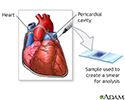Pericardial fluid Gram stain
Gram stain of pericardial fluid
Pericardial fluid Gram stain is a method of staining a sample of fluid taken from the sac surrounding the heart to diagnose a bacterial infection. The Gram stain method is one of the most commonly used techniques for the rapid diagnosis of bacterial infections.
How the Test is Performed
A sample of fluid will be taken from the sac surrounding the heart. Before this is done, some people may have a cardiac monitor to check for heart disturbances. Patches called electrodes are put on the chest, similar to during an electrocardiogram ( ECG ). You will have a chest x-ray or ultrasound before the test.
ECG
An electrocardiogram (ECG) is a test that records the electrical activity of the heart.

Chest x-ray
A chest x-ray is an x-ray of the chest, lungs, heart, large arteries, ribs, and diaphragm.

Ultrasound
Ultrasound uses high-frequency sound waves to make images of organs and structures inside the body.

The skin of the chest is cleaned with antibacterial soap. A trained physician, often a cardiologist, inserts a small needle into the chest between the ribs and into the thin sac that surrounds the heart (the pericardium). A small amount of fluid is taken out.
You may have an ECG and chest x-ray after the procedure. Sometimes the pericardial fluid is taken during open heart surgery.
A drop of the pericardial fluid is placed in a very thin layer on a microscope slide. This is called a smear. A series of special stains are applied to the sample. This is called a Gram stain. A laboratory specialist looks at the stained slide under the microscope, checking for bacteria.
The color, size, and shape of the cells help identify the bacteria.
How to Prepare for the Test
You will be asked not to eat or drink anything for several hours before the test. A chest x-ray or ultrasound may be done before the test to identify the area of fluid collection.
How the Test Will Feel
You will feel pressure and some pain as the needle is inserted into the chest and when the fluid is removed. Your doctor should be able to give you pain medicine so that the procedure does not hurt very much.
Why the Test is Performed
Your doctor may order this test if you have signs of a heart infection or a pericardial effusion (fluid buildup) with an unknown cause.
Pericardial effusion
Pericarditis is a condition in which the sac-like covering around the heart (pericardium) becomes inflamed.

Normal Results
A normal result means no bacteria are seen in the stained fluid sample.
What Abnormal Results Mean
If bacteria are present, you may have an infection of the pericardium or heart. Blood tests and bacterial culture can help identify the specific organism causing the infection.
Risks
Complications are rare but may include:
- Heart or lung puncture
- Infection
References
Knowlton KU, Narezkina A, Savoia MC, Oxman MN. Myocarditis and pericarditis. In: Bennett JE, Dolin R, Blaser MJ, eds. Principles and Practice of Infectious Diseases . 8th ed. Philadelphia, PA: Elsevier Churchill Livingstone; 2014:chap 86.
Little WC, Oh JK. Pericardial diseases. In: Goldman L,Schafer AI, eds. Goldman's Cecil Medicine . 24th ed. Philadelphia, PA: Elsevier Saunders; 2011:chap 77.
-
Pericardial fluid stain - illustration
Pericardial fluid that is obtained from the heart is stained with a violet stain known as gram stain. The sample is then examined under the microscope for the presence of bacteria. The color, number, and morphologic appearance of the cells help make it possible to identify the organism. The test is performed when an infection of the heart is suspected, or when a pericardial effusion is present.
Pericardial fluid stain
illustration
-
Pericardial fluid stain - illustration
Pericardial fluid that is obtained from the heart is stained with a violet stain known as gram stain. The sample is then examined under the microscope for the presence of bacteria. The color, number, and morphologic appearance of the cells help make it possible to identify the organism. The test is performed when an infection of the heart is suspected, or when a pericardial effusion is present.
Pericardial fluid stain
illustration
Review Date: 11/24/2014
Reviewed By: Daniel Levy, MD, PhD, Infectious Diseases, Lutherville Personal Physicians, Lutherville, MD. Review provided by VeriMed Healthcare Network. Also reviewed by David Zieve, MD, MHA, Isla Ogilvie, PhD, and the A.D.A.M. Editorial team.

